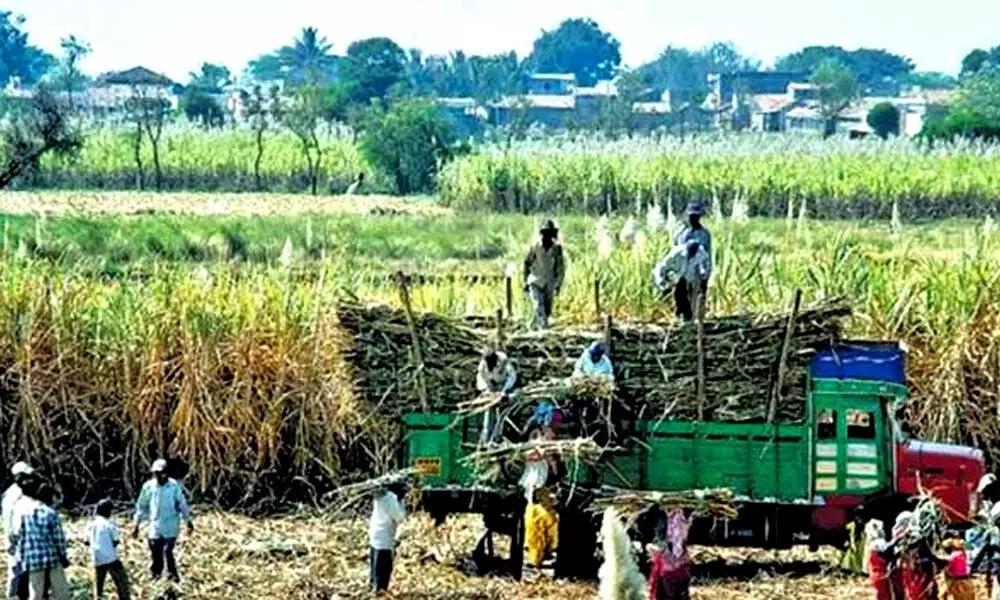Ethanol price hike under EBP to benefit sugarcane farmers
The Cabinet Committee on Economic Affairs (CCEA), headed by Prime Minister Narendra Modi, has finally given its go ahead for fixing a higher price for ethanol derived from different sugarcane-based raw materials under the Ethanol Blended Petrol (EBP) Programme for Ethanol Supply Year (ESY) 2021-22 starting from December.
image for illustrative purpose

The Cabinet Committee on Economic Affairs (CCEA), headed by Prime Minister Narendra Modi, has finally given its go ahead for fixing a higher price for ethanol derived from different sugarcane-based raw materials under the Ethanol Blended Petrol (EBP) Programme for Ethanol Supply Year (ESY) 2021-22 starting from December. The price of ethanol extracted from sugarcane juice has been increased to Rs 63.45 per litre from the current Rs 62.65 per litre for the supply year beginning next month. The rate for ethanol from C-heavy molasses is increased to Rs 46.66 per litre from Rs 45.69 per litre currently and that of ethanol from B-heavy to Rs 59.08 per litre from Rs 57.61 per litre.
This means that CCEA has increased the basic price of ethanol produced from C-heavy, B-heavy molasses and sugarcane juice by Rs0.97/ litre (or 2.1 per cent), Rs1.47/litre (or 2.6 per cent) and Rs0.8/litre (or 1.3 per cent) respectively for the ethanol supply year starting December 2021. With distillery contributing 17-25 per cent of integrated sugar mills' turnover, this increase in ethanol prices underpins continuation of supportive regulatory framework for enhanced ethanol blending. Sector analysts expect the operating margin of integrated sugar mills to expand by 30-50 bps pursuant to price hike announced. In addition, the price hike would encourage the industry to increase sucrose diversion towards ethanol to improve the domestic sugar supply demand balances that will in turn support domestic sugar prices, analysts feel.
Interestingly, oil marketing companies such as Indian Oil Corp (IOC), Bharat Petroleum Corp Ltd (BPCL) and Hindustan Petroleum Corp Ltd (HPCL), which procure ethanol from sugar mills and distilleries, will also bear the GST and transportation costs on the ethanol procured for doping in petrol. Meanwhile, the ethanol blending with petrol has touched eight per cent in the 2020-21 marketing year (December-November) and is expected to reach 10 per cent next year. It is pertinent to mention here that in his address to the nation on India's 75th Independence Day, Prime Minister Narendra Modi had emphasised on the need to transform India to an 'energy independent nation' before completing '100 years of independence', stressing on the country's transition towards cleaner sources of energy, such as bio fuels. He had also reiterated the target of 20 per cent ethanol blending (E20) by 2025, as envisaged under National Policy on Biofuels – 2018. Significantly, thanks to growth in both quantity of ethanol supplied to OMCs and the percentage of blending over the years, the Centre had preponed its target of E20 from 2030 to 2025, and E10 to 2022. However, India had produced only 485 million gallons in TE2020, against an annual demand of almost 1 billion gallon, and the rest is met through imports mainly from the US. Of the 173 crore litre of ethanol produced domestically in Ethanol Supply Year (ESY December-November) 2019-20, about 91 per cent came from sugarcane and the remaining 9 per cent from maize – 74.12 crore litre came from C-Heavy molasses, 68.14 crore litre from B-Heavy molasses, 14.83 crore litres from sugarcane juice and 15.08 crore litres from maize. In the current ESY, 332 crore litre with 8.5 per cent blending is expected. In this context, with an aim to achieve its E20 target by 2025, the government has allowed surplus stock of rice from the central pool (with Food Corporation of India or FCI) to be brought under ethanol production. The latest CCEA approval will not only facilitate the continued policy of the government in providing price stability and remunerative prices for ethanol suppliers but will also help in reducing the pending arrears of cane farmers and dependency on crude oil imports. It will also help in savings in foreign exchange and bring benefits to the environment.

